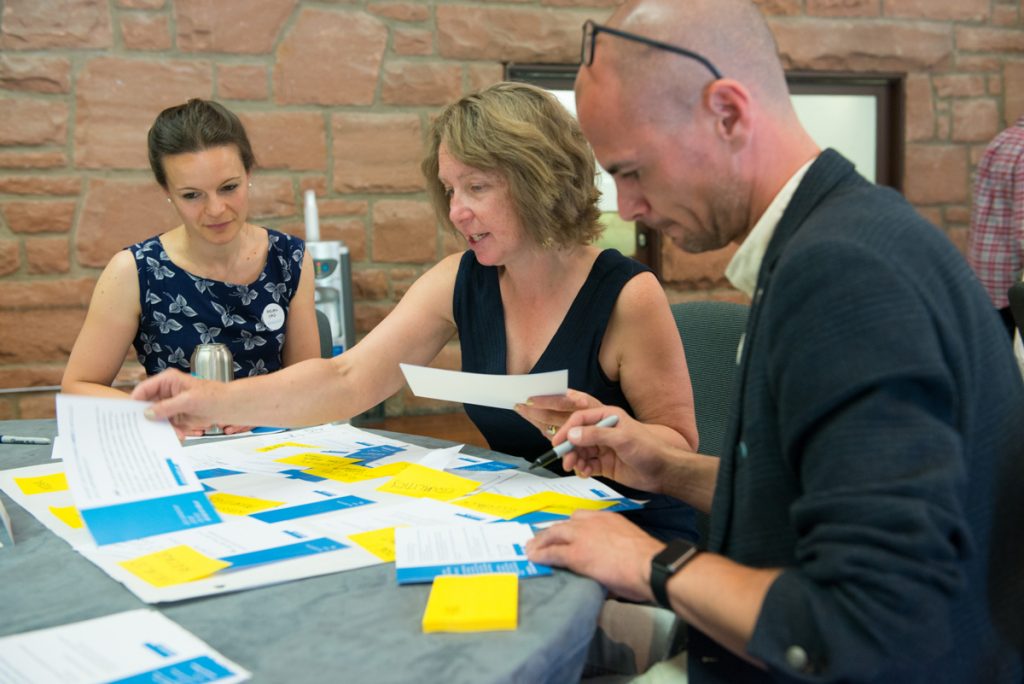What is service design?
Lots of organisations, from the Scottish Government to the NHS, are using service design approaches to develop their services. But what does this mean in practice?
In essence, this approach brings organisations together with the people who actually use their services to help them see the experiences from a customer perspective.
The value of service design is that it builds leadership, community and capacity building. We’ve been using this to develop the next version of our Corporate Plan.
Why choose service design?
2019 is the final year of our current Corporate Plan. This key document has steered how we prioritise our work and measure success for three years.
The current Corporate Plan has been very positively received, providing a solid foundation for our next steps.
But when we developed it, feedback told us we needed to get better at some things – like engaging with more diverse audiences. For the new plan, we decided to look into service design. Our hope is this approach will really involve and engage our wide and diverse audiences. Doing this will add even more value to the next Corporate Plan and deliver benefits for the historic environment.
‘I love the service design approach. I feel it gives everyone a voice. This has been a really successful process that I hope we continue to take forward.’ @HistEnvScot staff member on his experience of using new public outreach and engagement skillz. #HelloHES
— Leah Lockhart (@LockhartL) June 26, 2018
Our approach also involves staff from all over the organisation. By bringing everyone on the journey, the process of developing the Corporate Plan is just as important as the final document.
#HelloHES
We worked with Open Change to train around 60 staff on the tools and techniques of service design. We now have a huge team who can get out and ask people about their experiences and expectations of us, from Shetland to the Scottish Borders.
Our engagement sessions have been taking a variety of forms, including:
- Observing people using our services
- Open user interviews
- Vox-pop video interviews
These sessions have been taking place in a variety of settings including Our Place in Time group meetings, with staff at our Head Quarters, Edinburgh Pride and targeted team visits.

Online, our #HelloHES hashtag gives people on Twitter and Instagram a way to share thoughts and ideas to keep this conversation going. The feedback we’re receiving on social media will also be analysed as part of the service design process.
Through this consultation activity, we’ve engaged with a wide range of people and gained valuable insights before we start to draft the new Corporate Plan.
Insights and Ideas
At an event last week, around 90 people including HES staff, members of our Board, councils and partner organisations such as BEMIS and Young Scot got together to reflect on the feedback from over 400 people we’ve gathered from this engagement period.
Together, we refined the themes we’ll use to draft the Corporate Plan. It was an energetic, positive and dynamic day, with enlightening presentations from staff and stakeholders.
The two themes of ‘accessibility and inclusion’, and ‘community empowerment’ emerge as the main priorities for @HistEnvScot going forward, at least according to our table! #HelloHES pic.twitter.com/3ijDNar307
— Ben Thomas (@Baosbheinn) June 26, 2018
The draft of the next Corporate Plan will be well informed by the views of our staff, stakeholders and the public thanks to this service design approach.
Our service design experience
By implementing service design, we’re taking an innovative, creative and inclusive approach to development. This not only sets out our ambitions but creates a culture of strong leadership and good practice in citizen involvement. There’s a valuable legacy for HES as an organisation in the staff who have been trained in these methods and we’re already thinking about how it can be applied to other work.

We’ve made new contacts during this process which we hope will lead to improving our services for young people, equalities groups and communities.
The process has been a learning curve. Here are a few personal reflections from me:
- Equality matters
Seldom heard voices are not always hard to reach. If engagement with us isn’t straightforward, we need to look at how to make it easier for everyone to give their opinions on the future of Scotland’s historic environment. - Fail fast, fail forward
We should never be afraid of failure in driving innovation and to move out of our comfort zone. A safe environment to experiment is crucial. - Service design super stars
The process has been valued by staff who have energetically run with the approach to engagement. We have some real service design super stars in our midst here at HES. - Are you listening?
Be willing to hear what they have to say and you can learn a lot. - Heritage for all
The historic environment is valued by everyone – whether they’ve heard of HES (or the “historic environment”!) or not. - Keep the conversation going
Once you start, it’s hard to stop seeing opportunities for engagement!
Our next steps
We’ll be going out to formal consultation with a draft version of our Corporate Plan from August to November 2018.
Our engagement period will continue until the end of the formal consultation and we’ll be attending events around the country, like the Scottish Women’s Convention.
If you want to get involved, we’d love to hear from you. Send us a message online with #HelloHES and help inspire the future of our organisation.


